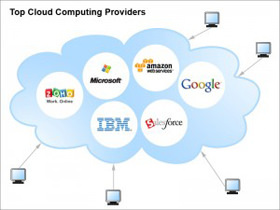A decade or so ago, service providers made a valiant attempt trying to change the way IT managed there applications and their data. There were a few issues that played a significant role in the demise of service provides back then however. First, there was a distinct lack of understanding of the velocity at which IT can and does change. Quite often I see infrastructure sales people proposing solutions to customer problems that require more of a “rip and replace” of existing infrastructure rather than complement it. Businesses don’t slow down. As new infrastructure is required to grow the business, the business still needs to keep moving. It’s a lot like trying to change the tires on a moving car.
Second, the network connectivity tended to preclude applications to connect to their data in a timely manner rendering the number of applications that could leverage the service provider less useful.
Finally, service provider sellers had a very difficult time talking to IT about the value proposition the service provider could bring to traditional IT as a complement to their existing business. This flimsy story, as well as concerns customers about security, data accessibility and other companies using their CPU cycles, customers we not motivated to bet their business on the “cloud”. Additionally, having dedicated hardware (server or storage) at a service provider actually provided no cost savings and was proven, over time, to actually cost more than managing it internally.
A decade later we have evolved quite a bit. The SSP’s of the past are now called “Cloud” providers. Cloud providers can now offer a set of offerings that span both servers as well as storage. Additionally the world’s internet connectivity is much more robust. Also cloud providers aren’t trying to boil the ocean. Cloud providers have a much better understanding of the type of applications they can service with a reasonable service levels. Multi-tenant technolgoy has also evolved such that it makes providing infrastructure as a service much more secure to clients making it more cost effective. VMware allows users to have dedicated servers, while virtual, to run their applications as well as keep costs low. Virtual servers lower the cost of high availability and make it easy to move servers throughout the infrastructure.
Physical servers have advanced to allow virtual servers to have their own memory and CPU allocated to them. The sharing of physical resources is much easier now without giving up service levels. Storage devices now offer features such as virtualization that allows storage to have much better utilization rates that save money. Servers as well as storage have better provisioning capabilities, making it easier to allocate and manage easier. All of these advancements have made cloud computing much easier and more cost effective to deploy.
One challenge IT still contends with within the cloud is application security. It is for this reason that there is still a bifurcation in the market. Clouds are now offered as public clouds as well as private clouds. Private cloud computing is managed by the IT department and usually on the customers premise. The upside is that IT can control the security and access in a private cloud easier than they can in a public cloud. Ultimately IT is deploying a flexible architecture that can be deployed that servers a number of purposes.
Cloud computing also seems to be driven by storage and capacity. There seems to be two types of cloud environments. There is true cloud computing where the server as well as the storage lives in the cloud. Users are allowed to log in with the proper credentials and allocate server processing, install an application and allocate storage to perform a task or a job. The user runs the application and stores the results in the cloud (this is very VDI like). Conversely there is cloud storage. In this example, storage is provisioned and allocated but the data is created and sent to the storage cloud, usually from outside the cloud (this is similar to backup to the cloud).
Today a majority of the “cloud’s” being deployed are private clouds. They are made up of virtual servers, a few physical servers, networking, storage, and security. These environments are very similar to traditional IT environments but are more flexible for the users. They are also used for IT applications or servers such as:
- Data protection
- Testing / Development
As IT grows to trust “cloud” more, we would expect to see it expand from “private cloud” to a more public cloud offering. Additionally, as applications are re-written for could services, we will see more services deployed to the cloud, however, today IT or applications don’t turn on a dime and until these applications are made “cloud ready” we will see a slow progression to the cloud.
